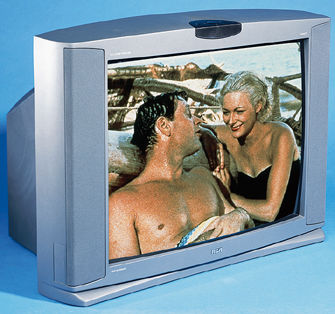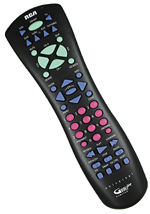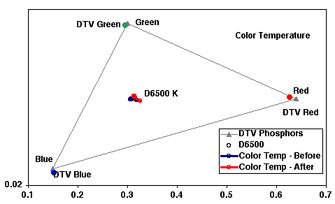Face Off: The Bridge on the River DTV RCA MM32110
The RCA proved to be the most interesting addition, given that opinions were relatively unanimous on all of the other sets but varied on this one. Everyone agreed that the RCA was solid and, in some respects, even more accurate than the Panasonic, based on the fact that the RCA ran more consistently around 6,500 degrees K (there are multiple color-temperature settings if you prefer a cooler look). A couple of things that the reviewers seemed to hold against the RCA, compared with the Sony or the Panasonic, were its lack of a line doubler and its lack of an anamorphic mode—and everyone had a different impression of how important these factors were. There are several quality outboard doublers that you could add to this set (such as the slick, $700 DVDO unit) that should give you much more performance than anything that would have been included. The RCA was the least expensive of the bunch at $1,749, but buying a separate line doubler would obviously add to your total cost. While he still officially listed the Sony as his favorite, I got the impression that, if Mike were to buy a set from this bunch, he might take the RCA and add the DVDO. Then again, he's big on the anamorphic widescreen feature, as we all are, and there's not much that can be done about its absence. In RCA's defense, this feature is far more the exception than the rule, but I have a feeling that this set might have finished number one on a couple of lists if it had included this mode.

Those omissions aside, the RCA is up to speed in the features department. It supports 1080i and 480p, and its component video inputs and dual S/VGA inputs should open up your options for line doublers and HDTV tuners, not to mention computer applications. Speaking of which, it also has USB inputs and an output. The RCA does offer SVM for those who prefer its effects, although it only appears to be defeatable by turning the sharpness control all the way down.

The VE test patterns indicated that the RCA handled DC restoration and that black levels were accurate. Brightness and contrast were fine on the patterns, but some reviewers had concerns about brightness with darker movies on DVD. The RCA did display some noticeable problems with cross-color artifacts and dot crawl, although bypassing the comb filter by avoiding the composite inputs will obviously make this a moot point. Color-decoder accuracy was solid overall; however, like the Panasonic, the RCA did push its greens. The RCA measured out at roughly 480 lines for NTSC.
 DVD material brought out mixed reactions from the reviewers. We all liked the accuracy of the RCA's color, but a couple of people expressed concerns over the overall darkness and lack of punch that the RCA offered with darker movies like Fight Club. Now, this again is a matter of personal preference. You'll notice that the movie modes on sets from most manufacturers will be darker and warmer overall, since this is how most videophiles prefer to watch film-based material. Granted, the RCA is dark, but this won't always be considered a negative. You can always turn up the color temperature, although that will affect the accuracy of the color, which is quite good on the RCA at the lowest setting. The lack of a line doubler was most noticeable with DVD material, and there were instances where the line structure was fairly obvious. A good outboard unit would obviously benefit this set.
DVD material brought out mixed reactions from the reviewers. We all liked the accuracy of the RCA's color, but a couple of people expressed concerns over the overall darkness and lack of punch that the RCA offered with darker movies like Fight Club. Now, this again is a matter of personal preference. You'll notice that the movie modes on sets from most manufacturers will be darker and warmer overall, since this is how most videophiles prefer to watch film-based material. Granted, the RCA is dark, but this won't always be considered a negative. You can always turn up the color temperature, although that will affect the accuracy of the color, which is quite good on the RCA at the lowest setting. The lack of a line doubler was most noticeable with DVD material, and there were instances where the line structure was fairly obvious. A good outboard unit would obviously benefit this set.
The RCA perked up noticeably with broadcast material, especially high-def images. Gone was the lack of punch, and the apparent sharpness of this set rose, as one reviewer put it, "dramatically." I noted that the RCA's performance with broadcast material was maybe only a hair weaker than that of the Sony's or the Panasonic's. Colors remained accurate, and the set's contrast definitely improved. DVD material—at least through the composite inputs—simply didn't seem able to unlock this set's dynamic range to the full potential that we ended up seeing with broadcast material.
The general consensus was that peripherals were adequate on the RCA. Its appearance is that of the standard-issue black box. The remote (a universal model that you'll recognize from most RCA products) is comprehensive and laid out pretty well. The onscreen menus were relatively intuitive and were made easier by a very detailed and easy-to-follow manual.
Highlights
• Quality color decoder
• Would be an even better performer with a little help

HT Labs Measures: RCA MM32110


The top chart shows the gray scale of the RCA MM32110 relative to its color temperature at various levels of intensity, or brightness (20 IRE is dark gray; 95 IRE is bright white). As you can see, the gray scale as set by the factory, in the most accurate menu setting, measures 6,700 Kelvin with dark images, leans more toward 6,800 K with medium-intensity images, and falls back to 6,700 K with brighter images. After making adjustments using the Photo Research PR-650, the gray scale measures within 200 degrees of D6500 K, the accurate setting, across the entire range. The bottom chart shows the gray scale (or color temperature) relative to the color points of the display's red, green, and blue CRTs. The color points match closely to those specified by SMPTE, which means the display will reproduce all the colors available in the system. The gray scale falls slightly blue before calibration and is more accurate afterward. The light output was approximately 27 foot-lamberts with a 15%-white window, which represents average picture material. The display could actually produce 28 ft-L with a full-white image. The display has at least 480 horizontal lines of resolution (per picture height) with NTSC sources. Technically, this is the best TV in the group.—MW
MM32110 $1,749
RCA Consumer Electronics
(317) 587-4450
www.rca.com
Dealer Locator Code RCA
- Log in or register to post comments

























































